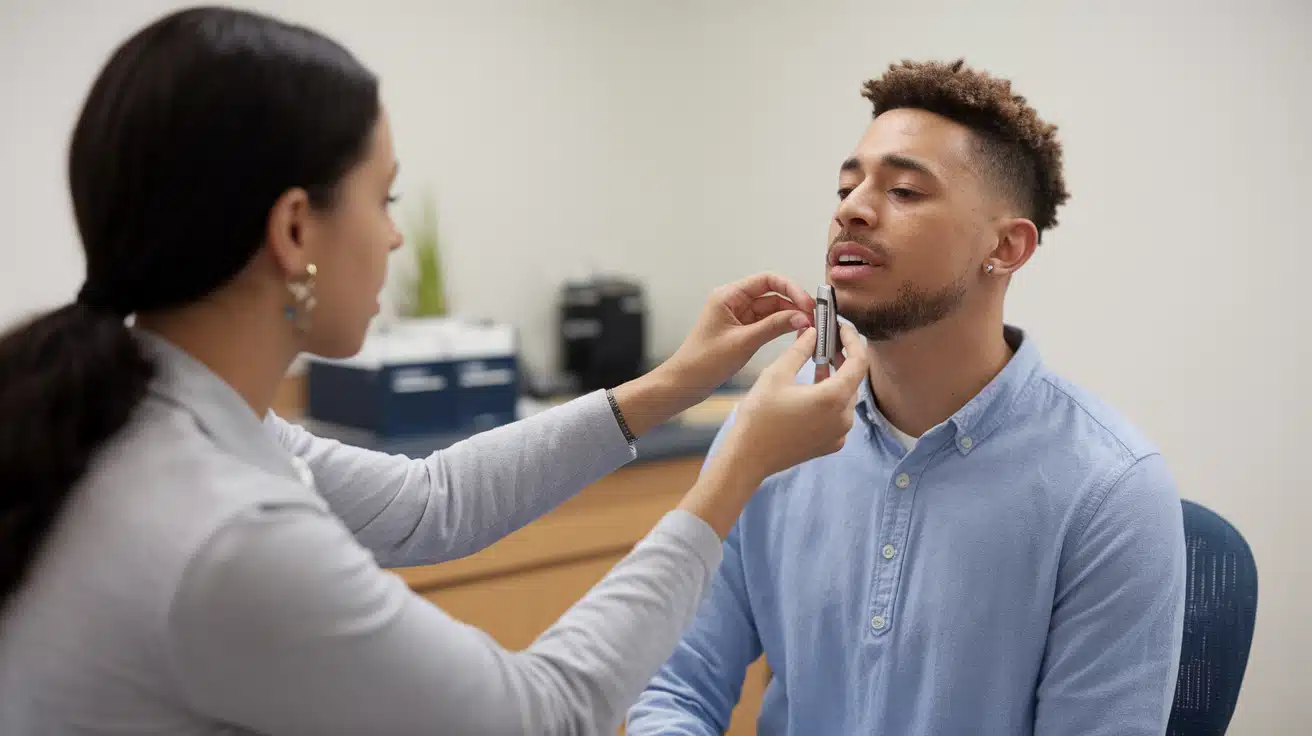Want to improve your voice? Resonant voice therapy exercises can help.
These techniques enhance your vocal quality, making it stronger and clearer.
Focusing on the balance of airflow and vocal cord function can help you develop a more effortless and sustainable voice.
Whether you’re dealing with voice issues or want to boost your vocal power, these exercises offer a path to better speech.
In this guide, we’ll explore practical resonant voice therapy exercises that you can try at home.
Get ready to discover how these simple yet effective techniques can transform your voice and boost your confidence in speaking.
Overview of Resonant Voice Therapy

Resonant voice therapy is a helpful tool for improving your voice. This section will explain what it is, how it works, and why it’s useful.
Resonant Voice Therapy (RVT) is a method to make your voice sound better and feel more comfortable. It’s all about helping you speak in a way that uses your body’s natural sound-boosting areas.
This therapy teaches you to:
- Speak with less effort
- Make your voice clearer and stronger
- Use your breath more effectively
RVT can help if you have voice problems or just want to improve how you sound. It’s especially good for people who use their voice a lot, like teachers or singers.
Benefits of Resonant Voice Therapy
RVT can help you in several ways:
- Your voice becomes clearer and easier to hear
- You can speak for longer without getting tired
- It can help with various voice issues, like roughness or breathiness
Research shows that RVT works well for many voice problems. People often notice their voice sounds better and feel more comfortable after doing these exercises regularly.
Immediate Guide to Resonant Voice Therapy Exercises
Ready to try some exercises? Here’s a quick start:
- Humming: Start with a gentle hum, feeling the vibration in your lips and face.
- Lip trills: Make a “brrr” sound, like you’re imitating a motor.
- Nasal sounds: Practice words starting with “m” or “n”, focusing on the buzzing feeling in your nose.
These simple exercises can help you start feeling the resonance in your voice right away.
Resonant Voice Therapy Exercises

This section covers the heart of resonant voice therapy: the exercises. We’ll explore four main types of exercises that can help improve your voice.
1. Vocal Placement Exercises
Goal: These exercises help you direct your voice into areas of your face and head that naturally boost sound.
How to Practice:
- Make a gentle “mmm” sound and notice where you feel vibrations.
- Try to focus those vibrations on your nose, lips, and cheeks.
- Gradually open your mouth while keeping the vibrations in these areas.
Result: Your voice will gain more depth and clarity, sounding fuller and more engaging.
2. Breathing Exercises
Goal: These exercises strengthen your breathing muscles, especially the diaphragm, for better voice support.
How to Practice:
- Lie down and place a hand on your belly.
- Breathe in deeply, feeling your belly rise.
- Breathe out slowly, feeling your belly fall.
- Repeat this pattern, focusing on smooth, relaxed breathing.
Result: You’ll have better control over your breath, which helps your voice sound steadier and reduces strain on your vocal cords.
3. Resonant Humming
Goal: This exercise engages your whole vocal system in a healthy way to boost resonance.
How to Practice:
- Start with a soft, comfortable hum.
- Feel for vibrations in your face, especially around your lips and nose.
- Gradually make the hum louder, then softer again.
- Try humming at different pitches while maintaining the vibrations.
Result: This warms up your vocal cords gently and helps them work together more smoothly.
4. Somatic Awareness Exercises
Goal: These exercises help you notice and release tension in your body that might be affecting your voice.
How to Practice:
- Gently roll your shoulders forward and back.
- Slowly turn your head from side to side.
- Let your jaw hang loose and give it a gentle massage.
- Take deep breaths and focus on relaxing any tight areas.
Result: By reducing physical tension, your voice can flow more freely, sounding more natural and relaxed.
5. Phoneme and Syllable Practice
Goal: This exercise helps you feel vibrations in the front of your face, which is key for a clear, resonant voice.
How to Practice:
- Start with the sound “mmm”.
- Gradually open your mouth to say “mum”.
- Play with the sound:
Make it louder, then softer
Try higher and lower pitches
Say it faster, then slower
Result: Your voice becomes more flexible and stronger, adapting easily to different speaking situations.
6. Chant Talk
Goal: This exercise teaches you to speak easily with a resonant voice.
How to Practice:
- Choose a simple sentence with lots of “m” sounds.
- Say it in a flat, monotone voice, like a chant.
- Focus on feeling vibrations in your face.
- Gradually add normal ups and downs to your voice while keeping the resonant feeling.
Result: You’ll learn to keep your voice resonant even when speaking normally.
7. Voiced and Voiceless Phrases
Goal: This exercise helps you maintain a resonant voice with all types of sounds.
How to Practice:
- Start with a phrase like “My mom made muffins”.
- Say it focusing on the resonant “m” sounds.
- Then try a phrase with both voiced and voiceless sounds, like “Peter picked peppers”.
- Practice keeping the resonant feeling even with the “p” sounds.
Result: Your voice will sound clear and controlled no matter what words you’re saying.
8. Conversation Practice
Goal: This exercise helps you use your new resonant voice in everyday talking.
How to Practice:
- Have a casual chat with a friend or family member.
- Focus on using your resonant voice techniques.
- Pay attention to how your voice feels throughout the conversation.
- If you lose the resonant feeling, take a moment to reset and try again.
Result: You’ll get better at using your resonant voice naturally in daily life.
These exercises build on each other, helping you develop a voice that’s not only clearer and stronger but also more comfortable to use. Remember, regular practice is key to seeing improvements in your voice.
Creating a Daily Practice Routine

Doing your voice exercises regularly is key to seeing real improvements. This section will help you set up a daily routine that fits into your life and keeps you on track.
Structure: Integrating Exercises into Your Day
- Start Small: Begin with 5-10 minutes of practice each day. It’s better to do a little every day than a lot once in a while.
- Choose a Consistent Time: Pick a time when you’re usually free, like right after waking up or during your lunch break.
- Mix It Up: Don’t do the same exercises every day. Rotate through different ones to work all aspects of your voice.
- Gradual Increase: As you get comfortable, slowly increase your practice time to 15-20 minutes.
- Set Reminders: Use your phone or sticky notes to remind yourself to practice.
Tips for Maintaining Progress
- Record Your Practice: Use your phone to record your voice at the start of each week. This helps you hear your progress over time.
- Keep a Log: Write down which exercises you do each day and how they felt. This can help you spot patterns and improvements.
- Self-Monitor: Pay attention to how your voice feels throughout the day, not just during practice. Are you using your new techniques in everyday speech?
- Be Patient: Voice changes take time. Don’t get discouraged if you don’t hear big differences right away.
- Stay Consistent: Even on busy days, try to do at least one or two quick exercises. Consistency is more important than perfection.
- Celebrate Small Wins: Notice and be happy about small improvements. Maybe your voice feels less tired at the end of the day, or you can speak a bit louder without strain.
By following these tips and creating a routine that works for you, you’ll be on your way to a stronger, clearer, and more comfortable voice.
Conclusion
Resonant voice therapy exercises can truly change how you speak and feel about your voice.
We’ve explored key techniques like vocal placement, humming, phoneme practice, and real-world conversation skills.
These exercises aren’t just for people with voice issues – they can help anyone who wants to speak more clearly and comfortably.
Remember, the magic happens with regular practice. Start small, maybe just 5 minutes a day, and build up.
You might be surprised at how quickly you notice changes. Your voice could become stronger, clearer, and less tiring to use.
Ready to unlock your voice’s full potential? Begin your journey today.











